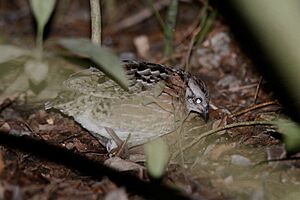Singing quail facts for kids
Quick facts for kids Singing quail |
|
|---|---|
 |
|
| Conservation status | |
| Scientific classification | |
| Genus: |
Dactylortyx
|
| Species: |
thoracicus
|
 |
|
The singing quail (Dactylortyx thoracicus) is a special type of bird. It belongs to the Odontophoridae family, which are also called New World quails. You can find this bird in countries like Belize, El Salvador, Guatemala, Honduras, and Mexico.
Contents
About the Singing Quail's Family
The singing quail is the only bird in its group, called a genus. This means it's quite unique! There are 11 different kinds, or subspecies, of singing quails. Each one might look a little different depending on where it lives.
- D. t. pettingilli
- D. t. thoracicus (Veracruz singing quail)
- D. t. sharpei (Yucatán singing quail)
- D. t. paynteri
- D. t. devius (Jaliscan singing quail)
- D. t. melodus
- D. t. chiapensis (Chiapan singing quail)
- D. t. dolichonyx
- D. t. salvadoranus (Salvadorean long-toed partridge)
- D. t. fuscus (Honduran long-toed partridge)
- D. t. conoveri
What Does a Singing Quail Look Like?
Singing quails are about 20 to 23 centimeters (8 to 9 inches) long. Male quails are usually heavier than females. Males weigh between 180 and 266 grams (6.3 to 9.4 ounces). Females weigh 115 to 206 grams (4.1 to 7.3 ounces). The smallest quails live near the ocean, and the biggest ones live in the mountains.
Adult male singing quails have a dark brown head and a mix of buff and black feathers around their neck. Their face is a warm orange color with a black stripe behind the eye. Their back and wings are a mix of gray and brown with thin white lines. The lower back is olive brown or gray with wavy black patterns. Their chest and belly are grayish-brown with white stripes. The lower part of their belly is white.
Female quails have a gray face and a white throat. Their chest and sides are a lighter brown. Young quails look similar to females but have black spots on their undersides. Quails living in mountain forests are often darker in color than those in drier, lower areas.
Where Do Singing Quails Live?
Singing quails live in several separate areas. You can find them in northern, western, and southern Mexico. They also live in the Yucatán Peninsula, northern Belize, and most of Guatemala. You might also spot them in some parts of El Salvador and Honduras.
These birds usually live on the ground in forests. They prefer areas where the plants under the trees are not too thick. You can also find them in older forests that are growing back. They live at the edges of very old forests, in areas where trees have been cut down, and even in coffee farms. They like forests in mountains and cloud forests, which are often misty. They can live from sea level up to at least 3,000 meters (9,800 feet) high.
Singing Quail Behavior
How Singing Quails Find Food
Singing quails often look for food in small groups. These groups usually have three to five birds, but sometimes up to 12 birds can be seen together. They scratch through fallen leaves and soil to find their meals. They eat things like plant bulbs, seeds, and insects.
Singing Quail Reproduction
The breeding season for singing quails seems to be from February to October. In the Yucatán area, groups of two to four young quails have been seen. We don't know much more about how they raise their young.
The Singing Quail's Song
The singing quail is known for its "loud, far-carrying, rhythmic song." Their song starts with slow, soft whistles. These whistles then get faster and higher in pitch, turning into a quick series of notes. Several quails in a group might sing together. They also make a soft chirping sound to stay in touch with each other.
Singing Quail Population Status
The IUCN (International Union for Conservation of Nature) has looked at the singing quail's population. They have decided that the bird is of "Least Concern." This means they are not currently worried about it becoming endangered. There are likely more than 100,000 singing quails. They are common in some places.
Singing quails seem to be better at surviving when their homes are changed or broken up than other quails in Central America. However, things like cutting down forests, hunting, and animals grazing in forests could still be threats to them.


